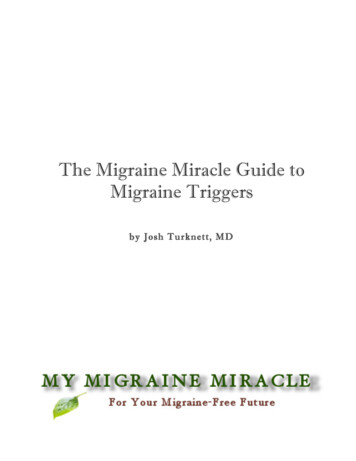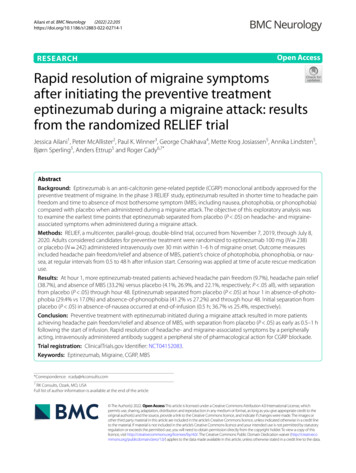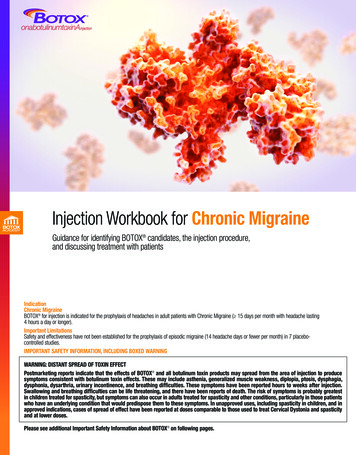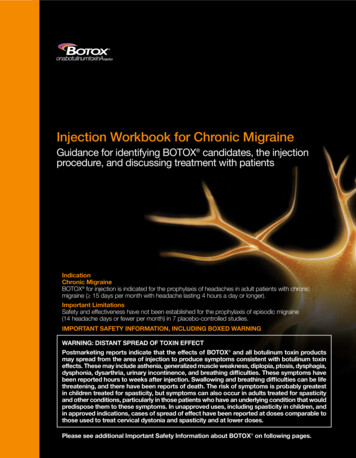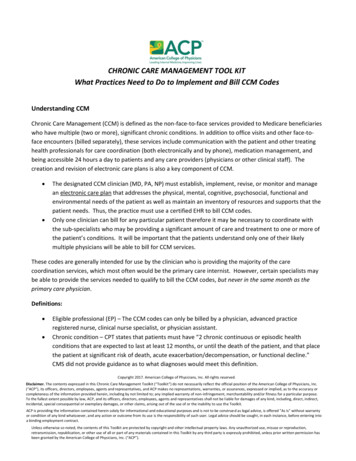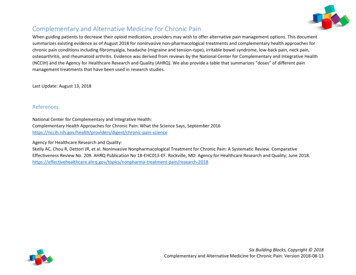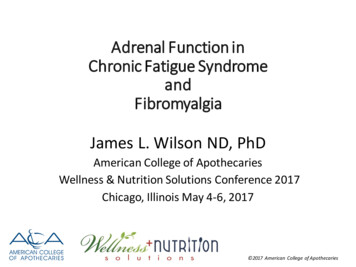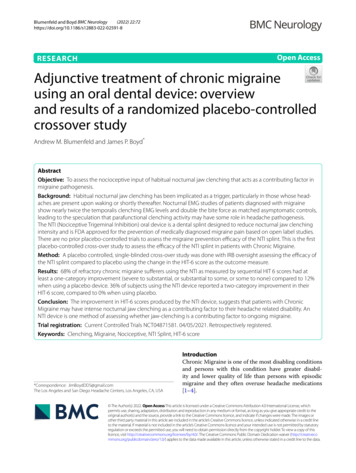
Transcription
(2022) 22:72Blumenfeld and Boyd BMC 8Open AccessRESEARCHAdjunctive treatment of chronic migraineusing an oral dental device: overviewand results of a randomized placebo‑controlledcrossover studyAndrew M. Blumenfeld and James P. Boyd*AbstractObjective: To assess the nocioceptive input of habitual nocturnal jaw clenching that acts as a contributing factor inmigraine pathogenesis.Background: Habitual nocturnal jaw clenching has been implicated as a trigger, particularly in those whose headaches are present upon waking or shortly thereafter. Nocturnal EMG studies of patients diagnosed with migraineshow nearly twice the temporalis clenching EMG levels and double the bite force as matched asymptomatic controls,leading to the speculation that parafunctional clenching activity may have some role in headache pathogenesis.The NTI (Nociceptive Trigeminal Inhibition) oral device is a dental splint designed to reduce nocturnal jaw clenchingintensity and is FDA approved for the prevention of medically diagnosed migraine pain based on open label studies.There are no prior placebo-controlled trials to assess the migraine prevention efficacy of the NTI splint. This is the firstplacebo-controlled cross-over study to assess the efficacy of the NTI splint in patients with Chronic Migraine.Method: A placebo controlled, single-blinded cross-over study was done with IRB oversight assessing the efficacy ofthe NTI splint compared to placebo using the change in the HIT-6 score as the outcome measure.Results: 68% of refractory chronic migraine sufferers using the NTI as measured by sequential HIT 6 scores had atleast a one-category improvement (severe to substantial, or substantial to some, or some to none) compared to 12%when using a placebo device. 36% of subjects using the NTI device reported a two-category improvement in theirHIT-6 score, compared to 0% when using placebo.Conclusion: The improvement in HIT-6 scores produced by the NTI device, suggests that patients with ChronicMigraine may have intense nocturnal jaw clenching as a contributing factor to their headache related disability. AnNTI device is one method of assessing whether jaw-clenching is a contributing factor to ongoing migraine.Trial registration: Current Controlled Trials NCT04871581. 04/05/2021. Retrospectively registered.Keywords: Clenching, Migraine, Nociceptive, NTI Splint, HIT-6 score*Correspondence: JimBoydDDS@gmail.comThe Los Angeles and San Diego Headache Centers, Los Angeles, CA, USAIntroductionChronic Migraine is one of the most disabling conditionsand persons with this condition have greater disability and lower quality of life than persons with episodicmigraine and they often overuse headache medications[1–4]. The Author(s) 2022. Open Access This article is licensed under a Creative Commons Attribution 4.0 International License, whichpermits use, sharing, adaptation, distribution and reproduction in any medium or format, as long as you give appropriate credit to theoriginal author(s) and the source, provide a link to the Creative Commons licence, and indicate if changes were made. The images orother third party material in this article are included in the article’s Creative Commons licence, unless indicated otherwise in a credit lineto the material. If material is not included in the article’s Creative Commons licence and your intended use is not permitted by statutoryregulation or exceeds the permitted use, you will need to obtain permission directly from the copyright holder. To view a copy of thislicence, visit http:// creat iveco mmons. org/ licen ses/ by/4. 0/. The Creative Commons Public Domain Dedication waiver (http:// creat iveco mmons. org/ publi cdoma in/ zero/1. 0/) applies to the data made available in this article, unless otherwise stated in a credit line to the data.
Blumenfeld and Boyd BMC Neurology(2022) 22:72Many patients with Chronic Migraine are refractory tomultiple preventive medications and others are reluctantto use pharmacotherapeutic treatments due to their systemic side effects [5]. In addition, many of these patientsare of child-bearing age and have concerns that thesemedications may produce teratogenic effects or miscarriages if they become pregnant.Migraine is an episodic disorder of neuronal dysfunction involving the trigemino-vascular system. As thecondition becomes chronic, sensitization occurs of thecentral sensory pathways [6], leading to.changes in pain and sensory input processing [7]. Painand sensory input to the trigeminal sensory nucleusis not limited to the first and second divisions of thetrigeminal nerve. Many Chronic Migraine patients haveparafunctional clenching activity and features of TMJdysfunction possibly due to trigeminal motor hyperactivity and dysfunction of the third division of the trigeminalnerve [8]. The role of habitual nocturnal jaw clenching asa contributing factor in migraine pathogenesis has notbeen established but has been implicated as a trigger [9],particularly in those whose headaches are present uponwaking or shortly thereafter [10].Jaw-clenching and bruxism can be nociceptive innature. These activities occur in association with arousals from deep sleep and occasionally REM sleep [11].Deep sleep predominates in the early portion of the sleepperiod while REM sleep occurs more toward the end ofthe sleep period. The timing of this nociceptive input maybe a trigger for headache on waking.Daily resting ambulatory EMG levels of the temporalis (the primary jaw clenching muscle) in persons withmigraine is not significantly different than matchedasymptomatic controls [12, 13].Nocturnal EMG studies of patients diagnosed withmigraine show nearly twice the temporalis clenching EMG levels and double the bite force as matchedasymptomatic controls, leading to the speculation thatparafunctional clenching activity may have some role inheadache pathogenesis [14]. Traditional mouthpieces (or“splints”) used to treat temporomandibular disorders aredesigned to reduce strain and load on the TM joint whilethe patient is clenching on the splint. This is accomplished by providing an ideal bi-lateral posterior clenching surface on the splint which immobilizes and stabilizesthe joint. However, this occlusal design provides an idealclenching surface for the molars and therefore cannotcurtail potential temporalis jaw-clenching intensity, andmay allow for jaw-clenching to intensify [15, 16] whichmay perpetuate migraine symptoms, resulting in the conclusion that “splints” are ineffective.When using a splint to treat a population of patientswho have headache attributed to a TM disorder,Page 2 of 9approximately 1/3 discontinue use due to an increase ofsymptoms, 1/3 will report no effect, while only 1/3 willimprove [17, 18].Intra-oral splints have traditionally been sub-dividedinto two broad categories: the full coverage splints, whichcover an entire dental arch; and the partial coveragesplints, which cover either the posterior molar segments,or the anterior segment (from canine to canine tooth). Byproviding for molar and/or canine contact through theirlong axis, both designs allow for ungoverned clenchingintensity. The Nociceptive Trigeminal Inhibition TensionSuppression System (NTI) is a partial coverage devicethat minimizes clenching intensity and the subsequentafferent nociceptive activity by providing for only incisor’s edges occluding contact on the splint (while ensuring canine and posterior molar separation). The NTI is asemi-custom intraoral mouthpiece approved by the FDAin 2001 for the prophylactic treatment of medically diagnosed migraine pain through reduction of trigeminallyinnervated muscular activity [19].MethodsA placebo controlled cross-over pilot study was donewith IRB oversight to assess the efficacy of the NTI splintusing the change in the HIT-6 score as the primary outcome measure. A power analysis was not done, as thispilot study’s results will indicate the signal if a largerstudy is warranted. The HIT-6 score was selected as theoutcome measure, as the goal was to focus on improving disability, as in chronic migraine, changes in headache days may not be as helpful as improving disability[20]. This was a single blind study and participants weretreated with both a placebo device and an NTI device.The participants were not aware of which device wasFDA approved, while practitioners were familiar with theNTI.Thirty consecutive refractory Chronic Migraine (CM)patients managed at a Neurology Headache Center,were referred to a dental practice to be considered forthe study. 25 consented and completed a baseline Headache Impact Test (HIT-6) questionnaire [21, 22]. TheHIT-6 measures both the severity of pain and the adverseimpact that headache has on the quality of the sufferer’slife.For this study a positive result was a one-level shift toa lesser HIT-6 category negative impact after use of theoral device: Little or no impact;Some impact with considerable pain;Substantial impact with severe pain;Severe impact with disabling pain.
Blumenfeld and Boyd BMC Neurology(2022) 22:72The subjects were consented and informed that thisstudy was designed to compare the efficacy of migraineprevention, if any, provided by two different intraoraldevices that were worn during sleep that were positioned and retained in the anterior region of the mouth.No other descriptions or details of the devices to be usedPage 3 of 9were discussed with the subjects. Each subject was thentreated with either an NTI device (Fig. 1) or a placebodevice (Fig. 2).The placebo device was custom fabricated on eachsubject by adapting a thermoplastic putty over the gingival surface within the maxillary labial sulcus spanningFig. 1 NTI device. 1) Initial closure. 2) Lower device 3) protrusive position. 4) retrusive position. The device must be modified to ensure incisor edgecontact in the extremes of each positionFig. 2 Placebo device. 1. No device. 2. Warmed thermoplastic in place 3. Cooled thermoplastic. 4. Final placebo device. 5. Placebo in place
Blumenfeld and Boyd BMC Neurology(2022) 22:72from maxillary canine to canine. The placebo intraoraldevice had no impact on the subject’s dental occlusionand no influence on nocturnal jaw muscle activity as itdid not limit contact of dentition important for clenchingactivity.This study used a pre-fabricated NTI device linedwith the same thermoplastic used for the creation of theplacebo.As per the manufacturer’s recommended protocol, each NTI device was customized to the subject tominimize temporalis contraction intensity by providing for an anterior mid-point contact with minimal vertical dimension of occluding (VDO). In those subjectswhose incisors opposing the NTI device were irregularlyaligned and/or whose incisal edges provided an irregularand non-continuous surface, an additional device wasadapted over the opposing incisor’s edges to provide asmooth and continuous surface (Fig. 3).Page 4 of 9The NTI device needs to be manufactured by a dentist knowledgeable in making this correctly (http:// www. nti- tss. com/ OVERS IGHTS. html). For example, in orderfor the activity of the trigeminally-innervated temporalis muscle to achieve pathologic intensity, either acanine or posterior molar must come into contact witheither another tooth or the device itself [23]. The NTIdevice therapy fails if either a canine or posterior toothchronically comes into contact with another tooth (or thedevice) during nocturnal parafunctional hyperactivity.Figure 4 illustrates an NTI device that had been improperly provided. Figure 5 demonstrates an NTI device thathas been properly provided.The EMG recordings shown in Fig. 6 demonstrate theeffect that the well-designed device has on trigeminalmotor maximum clenching activity. When used nightlyover a six-month period, maximum temporalis motoractivity as measured by EMG is reduced by over 50%[24].Subjects were randomized 1:1 to either 30 days of useof the NTI splint or 30 days of use of the placebo splint.After 30 days of nightly use, subjects completed anotherHIT-6 and were then switched to the alternate device.No mention of the subject’s previous or current HIT-6score, or the nature of the devices being delivered, werediscussed or mentioned. After another 30 days of nightlyuse, subjects completed a final HIT-6.Limitations of the study: Single blind leading to potential bias.ResultsFig. 3 Opposing NTI devices to provide for minimal lateral resistance.The greater the surface area of contact, the more intense theclenching activity can be, therefore, the contacting surface areashould be minimized 19 of the 25 subjects completed the 2-month trial.(the 6 dropouts either failed to return for check-ins,or did not comply with the protocol) Initial baseline average HIT-6 of all subjects: Category 4: “Severe impact, disabling pain”Fig. 4 Improper NTI Protocol. Arrows indicate canine contact on the NTI device when the patient’s jaw shifts laterally. Canine contact allows forintense trigeminal motor hyperactivity (clenching), creating considerable strain to the contralateral temporomandibular joint, potentially producingexcessive nociception
Blumenfeld and Boyd BMC Neurology(2022) 22:72Page 5 of 9Fig. 5 Corrected NTI protocol. By maintaining incisor edge contact and preventing canine or posterior tooth contact during the parafunctionalacts, the properly-aligned NTI keeps both the muscle contraction intensity and strain on the distracted temporomandibular joint to a minimumFig. 6 Temporalis EMG of Maximum Clenching Intensity over the anterior left and right temporalis muscle (TA-L and TA-R) 68% of subjects (17 of 25) using the NTI device hadat least a one-category improvement in their HIT-6scores compared to 12% (3 of 25) when using placebo (Fig. 7). 36% (9 of 25) of subjects using the NTI devicereported a two-category improvement in theirHIT-6 score, compared 0% when using placebo(Figs. 8 and 9). There were no adverse effects reported by any ofthe subjectsStatistical analysis in reduction in categories of negative impact.HIT-6 Score ImprovementNTI 1 category14/19 74%2 categories9/19 47%Placebo3/19 16%0%The Fisher test was implemented to see if there wasa statistically significant difference in HIT-6 ScoreImprovement (rather than a Chi-Square, as one table scell contained less than 5 observations and the samplesize was less than required 40, which are assumptionsof the Chi-square test).The Fisher test revealed (p 0.00125), that there is astatistically significant difference between NTI and Placebo improvement.The non-parametric Friedman’s test, a non-parametrictest for finding differences in treatments across multipleattempts, revealed that there was significant differencebetween baseline HIT-6 scores, NTI and Placebo values(X(2) 32.4, p 0.001).DiscussionMigraine is a disease that involves overactivity in thetrigeminal-occipital-cervical complex of the nerves.These afferents feed into the trigeminal nucleus caudalis.Decreasing peripheral sensitization with modalities suchas the NTI splint protocol which reduces chronic nociceptive input can help to decrease central sensitization,which is a hallmark of Chronic Migraine.The purposeless nocturnal parafunction of jaw clenching, with or without forcible excursive movements(grinding), can produce abundant nociceptive input tothe sensory nucleus, with the intensity of contraction ofthe elevator muscles dictating the degree of nociception.As elevator contraction intensity increases, so does thepressure and strain on the teeth, the periodontal ligaments and temporomandibular joints, while the antagonist muscles (lateral pterygoids) strain to depress themandible and separate the teeth. During unilateral posterior clenching in excursive mandibular positions, considerable strain is endured by the distracted contralateraljoint.
Blumenfeld and Boyd BMC Neurology(2022) 22:72Page 6 of 9Fig. 7 Comparison of effect of NTI vs Placebo on degree of negative impact of Chronic Migraine on individual subjectsFig. 8 Reduction in categories of negative impactWhen elevator intensity (degree of jaw clenching) isminimized, the force of contact on the teeth and resulting nociceptive input is also minimal, thereby presentingthe lateral pterygoids with less resistance to their activitywhich minimizes the potential direct strain and load onthe TM joints.Therefore, the therapeutic design of a nocturnalintraoral device would be to provide nocturnal full-time
Blumenfeld and Boyd BMC Neurology(2022) 22:72Page 7 of 9Fig. 9 Crossover comparisons of the 19 subjects who completed the trial, changes in HIT-6 scores for each group. (a HIT-6 score of 49 equates tono impact on the subject’s life (percent changes are therefore relative to a score of 49)Fig. 10 Percent reduction of listed symptoms during second month of NTI use compared to Control Device in the initial FDA trial studyFig. 11 Percent reduction of migraine events of individual full-coverage control splint users (Elkhart site) during second month of use in the initialFDA trial study
Blumenfeld and Boyd BMC Neurology(2022) 22:72Page 8 of 9Fig. 12 Percent reduction of migraine events for individual NTI users (Elkhart site) during second month of use in the initial FDA trial studyposterior disclusion with incisor edge contact (“incisalguidance” [25]) to minimize the influence of chronicnocturnal nociception on the triggering of a headache byensuring two criteria:include prior experiences of patients with negative outcome from traditional dental splints, and a lack of knowledge by providers of clenching pathophysiology and thisalternative option.1) to minimize jaw-clenching intensity (primarily thetemporalis), by providing for incisor edge contact, only;2) to minimize TM joint strain and load [26] by minimizing the resistance encountered by the lateralpterygoids (via the provision of smooth articulatedsurfaces) and the degree of condylar rotation during the clenching events by minimizing the verticaldimension of occluding (VDO).ConclusionThe improvement produced by the NTI device (Figs. 7,8 and 9) suggests that Chronic Migraine patients mayhave nocturnal jaw clenching as a contributing factor,and this may be undiagnosed by health care providers.The production of nociceptive input by the affectedteeth, bone, TMJs and muscles to the trigeminal sensory nucleus produced by nocturnal jaw clenchingshould be considered as a potential perpetuating andconfounding co-factor of Chronic Migraine. An NTIdevice should be considered as a method of assessingwhether jaw-clenching is a contributing factor to ongoing migraine.For the FDA approval study [27, 28] the NTI was compared with a traditional dental splint as a control device[29], for the prophylactic treatment of migraine pain.During the second month of use, overall, the controldevice performed as expected, while the NTI was nearlytwice as effective (Figs. 10 and 11).The outcomes for the control splint, nearly as manysubjects reporting considerable worsening of symptoms(shown as a negative percent reduction) as those reporting improvements (Fig. 12).In contrast, 82% of subjects using the NTI-TSSreported a mean 77% reduction in migraine events, withless than 5% reporting an increase in symptoms.To date, the NTI has yet to become a commonly usedadjunctive preventive treatment. The reasons for this mayDisclosuresNTI devices were provided by ChairsideSplintStore.com,the exclusive distributor of the NTI devices.Dr. Blumenfeld has acted as a consultant for NationalDentex Labs, a provider of NTI devices.AbbreviationNTI: Nociceptive Trigeminal Inhibition.
Blumenfeld and Boyd BMC Neurology(2022) 22:72AcknowledgementsNot applicableConflict of interestAuthor: Advisory Board: Allergan, Aeon, Alder, Amgen, Biohaven, Lilly, Novartis,Revance, Teva, Theranica, Zoscano. Speaker: Allergan, Amgen, Lilly, Teva. Consultant: Allergan Alder, Amgen, Biohaven, Lilly, Novartis, Teva, Theranica, Zoscano and National Dentex Labs, Grant support: Allergan, Amgen. Contributingauthor: Novartis, Teva, Allergan, Biohaven. Corresponding author: Financialinterest in ChairSideSplint.com, provider of the NTI devices.Authors’ contributionsAB analyzed and interpreted the patient data regarding the HIT-6 responses, andwas the sole contributor in writing the manuscript. AB has read and approvedthe final manuscript. The author(s) read and approved the final manuscript.Author’s informationDirector of The Headache Center of Southern California, San Diego. Particularinterest in trigeminally mediated disorders of the third division.FundingNo financial funding was provided. NTI devices were donated by ChairsideSplintStore.com, distributor of the NTI devices.Availability of data and materialsThe datasets used and/or analyzed during the current study are available fromthe corresponding author on reasonable request.DeclarationsEthics approval and consent to participateThe study was approved by the Institutional Review Board of BioMed IRB, POB600870, San Diego, CA 92160. (619) 282–9998. wwwBIOMEDIRB.com. Protocolnumber: “NTI-MIGRAINE”.Each participant completed a comprehensive informed consent. All methodswere performed in accordance with the relevant guidelines and regulations.Consent for publicationNot applicable.Competing interestsThe author declares that he has no competing interests.Received: 1 June 2021 Accepted: 18 February 2022References1. Castillo J, Munoz P, Guitera V, Pascual J. Epidemiology of chronic dailyheadache in the general population. Headache. 1999;39:190–6.2. Silberstein SD, Lipton RB. Chronic daily headache. Curr Opin Neurol.2000;13:277–83.3. Pascual J, Colas R, Castillo J. Epidemiology of chronic daily headache. CurrPain Headache Rep. 2001;5:529–36.4. SD Silberstein 2005 Transformed and chronic migraine Goadsby, Silberstein, S,Dodic D, eds. Chronic Daily Headache for Clinicians. Hamilton,Ontario: BC Decker,Inc.::21–565. Rozen TD. Migraine prevention: What patients want from medicationand theirphysicians (a headache specialty clinic perspective). Headache.2006;46(5):750–3.6. Goadsby PJ. Migraine pathophysiology. Headache. 2005;45(suppl 1):S14–24.7. Silberstein, S. Current preventive therapy: Preventive treatmentmechanisms,Headache Currents, Vol.3, #5/6, Sept/Nov 20068. Graff-Radford S, Newman A. The role of temporomandibular disordersandcervical dysfunction in tension-type headache. Current Pain andHeadache Reports. 2002;6:387–91 Current Science Inc, ISSN 1531-3433.9. Steele JG, et al. Occlusal abnormalities, pericranial muscle and jointtenderness, andtooth wear in a group of migraine patients. J Oral Rehabil.1991;18(5):453–8.Page 9 of 910. Lamey PJ, Barclay SC. Clinical effectiveness of occlusal splint therapy inpatients with classical migraine. Scott Med J. 1987;32:11–2.11. Yap A, Chua A. Sleep bruxism: Current knowledge and contemporarymanagement. J Conserv Dent. 2016;19(5):383–9.12. Clark G, Sakai S, Merrill R, Flack V, McArthur D, McCreary C. Waking andSleeping EMG Levels in Tension-Type Headache Patients. J Orofacial Pain.1997;11:298–305.13. Graff-Radford SB. Oromandibular disorders and headache: A criticalappraisal. Neurol Clin. 1990;8:929–45.14. Burnett CA, Fartash L, Murray B, Lamey JP. Masseter and Temporalis Muscle EMG and Bite Force in Migraineurs. Headache. 2000;40:813–7.15. Chandu A, et al. The effect of an interocclusal appliance on bite force andmasseter electromyography in asymptomatic subjects and patients withtemporomandibular pain and dysfunction. Oral Rehabil. 2004;31(6):530–7.16. Nishigawa K, et al. Quantitative study of bite force during sleep-associated bruxism. J Oral Rehab. 2001;28:485–91.17. Hansson, T.L. "Orthopedic Appliances" In: Current Controversies inTemporomandibular Disorders, R. McNeil, Ed. Quintessence, 199118. Solberg, W.K. In: Perspectives in Temporomandibular Disorders, G.T. Clark,Ed. p.180. Quintessence 198719. FDA summary: https:// www. acces sdata. fda. gov/ scrip ts/ cdrh/ cfdocs/ cfPMN/ pmn. cfm? ID K0108 7620. Tassorelli C, et al. Guidelines of the International Headache Society forcontrolled trials of preventive treatment of chronic migraine in adults.Cephalalgia. 2018;38(5):815–32.21. El Hasnaoui A, et al. Tools for assessing patient perception of the impactof migraine. CNS Drugs. 2006;20 Spec no.1:24–36.22. DeDiego EV, Lanteri-Minet M. Recognition and management of migrainein primary care: Influence of functional impact measured by the headache impact test (HIT). Cephalalgia. 2005;25(3):184–90.23. Fitins D, Sheikholeslam A. Effect of canine guidance of maxillary occlusalsplint on level of activation of masticatory muscles. Swed Dent J.1993;17(6):235–41.24. Boulad J, et al. Effects of Treatment with Nociceptive Trigeminal Inhibition Splints on Electromyography in Temporomandibular Joint DisorderPatients. J Contemp Dent Pract. 2019;20(5):598–602.25. Schuyler D. The function and importance on incisal guidance in oralrehabilitation. J Pros Dent. 2001;86(3):219–32.26. May BM, Garabedian C. Reducing condylar compression in clenchingpatients. Crit Rev Biomed Eng. 2000;28(3–4):389–94.27. Shankland, WE. Migraine and tension-type headache reduction throughpericranial muscular suppression: a preliminary report CRAINO. 2005 Mar,25(3):184-90.28. Shankland WE. Nociceptive trigeminal inhibition–tension suppressionsystem: a method of preventing migraine and tension headaches. Compend Contin Educ Dent. 2001;22(12):1075–80.29. Lamey PJ, et al. Migraine: the effect of acrylic appliance design on clinicalresponse. Br Dent J. 1996;180(4):137–40 Feb 24.Publisher’s NoteSpringer Nature remains neutral with regard to jurisdictional claims in published maps and institutional affiliations.Ready to submit your research ? Choose BMC and benefit from: fast, convenient online submission thorough peer review by experienced researchers in your field rapid publication on acceptance support for research data, including large and complex data types gold Open Access which fosters wider collaboration and increased citations maximum visibility for your research: over 100M website views per yearAt BMC, research is always in progress.Learn more biomedcentral.com/submissions
There are no prior placebo-controlled trials to assess the migraine prevention ecacy of the NTI splint. This is the rst placebo-controlled cross-over study to assess the ecacy of the NTI splint in patients with Chronic Migraine. Method: A placebo controlled, single-blinded cross-over study was done with IRB oversight assessing the ecacy of
